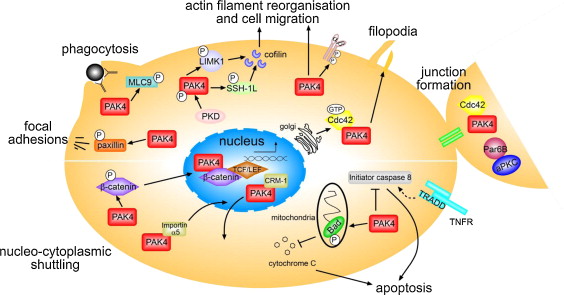What is PAK4 Protein
The PAK4 protein, officially known as p21-activated kinase 4, belongs to the family of p21-activated kinases (PAKs). It is also referred to by synonyms such as PAK4, PAKγ, and PAKB. PAK4 is a serine/threonine protein kinase that plays a crucial role in various cellular processes. Recent research advances have shed light on its significance in cellular signaling, making it a subject of growing interest in the scientific community.
PAK4 is a member of the PAK family, which includes several other kinases, namely PAK1, PAK2, PAK3, and PAK5. Structurally, PAK4 consists of an N-terminal regulatory domain and a C-terminal catalytic domain. This arrangement allows PAK4 to function as a kinase, transferring phosphate groups to target proteins and modulating their activity. Recent studies have elucidated the unique structural characteristics of PAK4 that contribute to its specific functions in cellular processes and signaling pathways.
PAK4 Biological Functions and Molecular Mechanisms
The biological functions of PAK4 are diverse and significant. This kinase is primarily involved in regulating cellular processes such as cytoskeletal dynamics, cell migration, and cell survival. PAK4's molecular mechanisms can be broken down into several key roles:
- Regulation of Cell Migration: PAK4 is a critical regulator of cell motility. It influences the reorganization of the actin cytoskeleton, which is essential for cell movement. By phosphorylating and activating proteins involved in cytoskeletal dynamics, PAK4 plays a central role in the migration of cells, an essential process in development, tissue repair, and cancer metastasis.
- Cell Survival and Anti-apoptotic Functions: PAK4 also contributes to cell survival by suppressing apoptosis (programmed cell death). It achieves this by phosphorylating proteins involved in apoptotic pathways, ultimately promoting cell survival. Dysregulation of PAK4 can contribute to cancer development by inhibiting cell death mechanisms.
- Cell Signaling and Gene Expression: PAK4 can activate various signaling pathways, influencing gene expression and cellular responses. It interacts with other proteins and kinases, affecting downstream signaling events, such as those mediated by the Rho GTPases.

Figure 1. The biological functions of P21-activated kinase 4. (Dart A E, et al., 2013)
PAK4 Related Signal Pathway
PAK4 is intricately involved in multiple signal transduction pathways. One of the well-studied pathways is its connection with Rho GTPases, including Cdc42 and Rac1. These interactions regulate cytoskeletal dynamics, cell migration, and gene expression, all of which are pivotal for cellular functions. Additionally, PAK4's role in the MAPK/ERK signaling pathway and PI3K/Akt pathway has been explored, highlighting its involvement in various cellular processes and disease states.
PAK4 Related Diseases
The dysregulation of PAK4 has been linked to several diseases, most notably cancer. In various cancer types, overexpression or aberrant activation of PAK4 can promote cell survival, migration, and invasion, contributing to tumor progression. Furthermore, PAK4 has been associated with other diseases and conditions, including neurological disorders, autoimmune diseases, and cardiovascular diseases. In-depth research on PAK4's involvement in these diseases is ongoing, with the aim of identifying potential therapeutic targets and diagnostic markers.
PAK4's Applications in Biomedical
The multifaceted functions and signaling pathways of PAK4 have paved the way for its applications in biomedical research and development. Here are some of its notable applications:
- Diagnostic Development: PAK4 has the potential to serve as a diagnostic marker for certain diseases, particularly cancer. Elevated PAK4 levels in cancer tissues can be indicative of aggressive tumors. Researchers are working on developing diagnostic tests that measure PAK4 expression to aid in early cancer detection and prognosis assessment.
- Vaccine Development: PAK4's role in cancer and its overexpression in tumor cells make it an interesting target for therapeutic vaccines. These vaccines aim to stimulate the immune system to recognize and attack cancer cells specifically, leveraging PAK4 as an antigen for vaccine development.
- Therapeutics: Pharmaceutical companies are actively exploring the development of small molecules and biologics that target PAK4 for cancer therapy. Inhibiting PAK4 activity may prevent cancer cell survival, migration, and invasion, making it a potential therapeutic strategy in the fight against cancer.
Recommended Products
| Cat.# | Product name | Species | Source (Host) | Tag |
|---|---|---|---|---|
| PAK4-1603H | Recombinant Human PAK4 Protein, His (Fc)-Avi-tagged | Human | HEK293 | His (Fc)-Avi |
| PAK4-380H | Recombinant Human PAK4, GST-tagged, Active | Human | Sf9 Insect Cell | GST |
| PAK4-382HFL | Recombinant Full Length Human PAK4 Protein, C-Flag-tagged | Human | Mammalian cells | Flag |
| PAK4-766H | Recombinant Human PAK4 Protein, His-tagged | Human | E.coli | His |
| PAK4-69H | Recombinant Human PAK4 protein, Flag-tagged, Biotinylated | Human | Insect Cell | Flag |
| PAK4-3407HF | Active Recombinant Full Length Human PAK4 Protein, BTN-tagged | Human | Insect (sf21) | BTN |
| PAK4-319H | Recombinant Human PAK4 Protein, MYC/DDK-tagged, C13 and N15-labeled | Human | HEK293 | C-Myc/DDK |
| PAK4-1647HF | Active Recombinant Full Length Human PAK4 Protein, GST-tagged | Human | Insect (sf21) | GST |
| PAK417138H | Recombinant Human PAK4 (300-591) Protein | Human | ||
| PAK4-1603H | Recombinant Human PAK4 Protein, His (Fc)-Avi-tagged | Human | HEK293 | His (Fc)-Avi |
Reference
- Dart A E, Wells C M. P21-activated kinase 4–not just one of the PAK. European Journal of Cell Biology. 2013, 92(4-5): 129-138.

